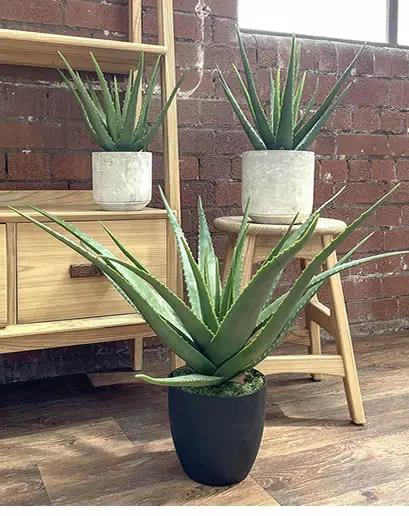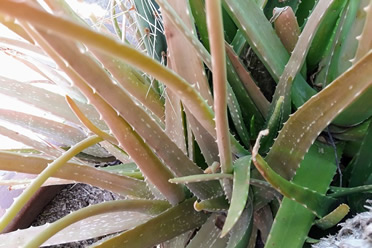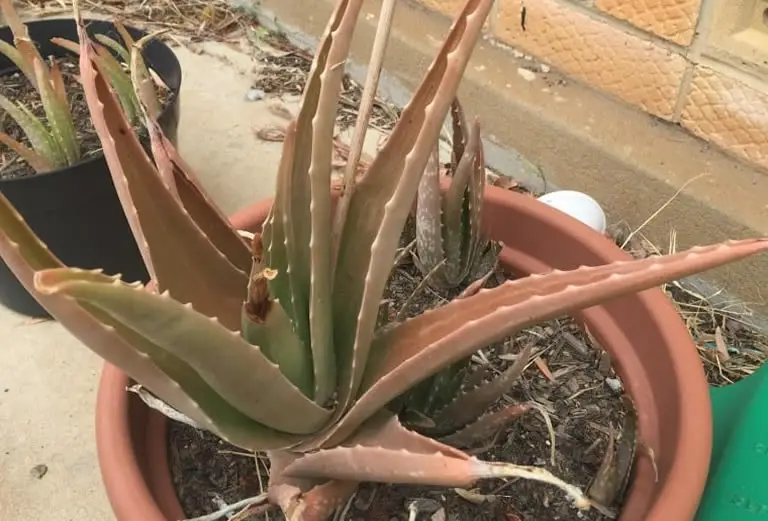In this article I outline the most common causes for the browning of leaves on aloe plants. When your aloe plant starts to turn brown it is important to investigate and find the cause as a few of them are very serious. So failing to properly identify the cause, and then treat it, when the leaves turn brown could lead to the death of the plant.
In this post I cover all potential causes for aloe plant browning and outline the steps you need to take to fix the problem.
Table of Contents
The real cause behind an aloe plant turning brown
In all the years that I have been tending to gardens, cultivating plants and growing houseplants I have yet to see an aloe vera or other aloe plant turning brown where the cause was not water related.
9 Times out of 10 the cause for an aloe plant turning brown will be:
- Root rot.
Root rot is almost always caused by overwatering. In some instances root-attacking pests can also cause a browning of an aloe plant’s foliage.
Although the actual culprit may be different, bot overwatering the plant and root attacking pests create a condition in the plant known as root rot.
Root rot will deprive the plant of nutrients and moisture (even though the plant soil could be drenched with water).
As the roots rot they become unable to absorb moisture and thus cannot distribute that water, and the nutrients it carries, to the outer parts of the plant.
Although too much fertilizer can burn the leaves on an aloe plant this is unlikely to be the cause behind your aloe plant turning brown.
Over-fertilization is more likely to burn the tips of the leaves of an aloe than it is to effect the entire foliage. You will see why as you read through this article.
Aloe plants are tough succulents that have evolved to be tough and hard to kill. This makes them perfect houseplants as they require very little care and attention.
Unfortunately though, when you overdo their care (especially when it comes to watering) it can have a disastrous effect on the plant.
Aloe plants have evolved to be tough but this can be their downfall
Aloe are tropical plants that grow natively in parts of Africa and several other locations such as Jordan, Madagascar, the Arabian Peninsula and various islands in the Indian Ocean such as Mauritius, Comoros and Réunion.
These plants have evolved over a long time to tolerate, and even thrive in, areas that would be completely uninhabitable for other plants.

Even some succulents, such as amaryllis, would find it difficult to survive in the desert-like conditions that aloe plants thrive in.
Not only are aloe plants well-suited to dry, semi-arid areas but they can also tolerate a lot of strong sunlight and very little water.
This makes aloe plants a very easy-care houseplant because they require very little tending by their owners.
As long as an aloe houseplant has its basic needs met it will happily live without much input from the householder.
So why do some aloe houseplants develop problems if they are such an easy-care plant?
Well, when a problem arises the problem almost always lies in the aloe plant care routine.
Aloe plants may be easy-care succulents. They are low maintenance plants that require only a simple care routine but if you get that simple care routine wrong the results can be disastrous.
So, even when you identify the cause of the browning of your specific aloe plant from the information I provide below and take action to fix the problem you should not rest easy.
I encourage you to read my aloe plant leaves care guide to ensure you are giving your plant the correct care so you don’t encounter any future problems.
Let’s get on to the problem of browning aloe plants so you can quickly identify what is causing the problem in your specific plant and learn what you need to do to fix it.
Why it may seem like your aloe is turning brown in the sun & why the sun is unlikely to be causing it
So, you’ve recently moved your aloe plant into a sunny position – a wise choice as this succulent needs at least 6 hours of direct sunlight per day.
However, you can see that your plant has started to turn brown. What could be causing this problem and what can you do to fix it?
The sun is unlikely to be the cause of your aloe plant turning brown.
Occasionally too much strong sun over prolonged periods can bleach the leaves of an aloe plant turning them yellow/brown but this is not common.
The cause is more likely to be water related and, if this is the case, you must take immediate action to save your plant.
Aloe plants, having evolved in dry warm places that receive a lot of strong direct sunlight.
They rarely react negatively to be placed in full sun (see our guide to the light requirements of aloe plants).
The only negative effects you will see with a aloe plant that is getting a lot of strong direct sunlight is a yellowing of the leaves.

If left unattended the leaves can fade in more in color displaying a more brown hue.
If your plant is getting too much strong direct sunlight, for many hours per day, then simply moving it to an area that gets direct light for most of the day. But make sure that the area also falls into shadow for part of the day, is the best solution.
If it is an outdoor garden plant you may want to erect some form of shelter from the plant to protect it from prolonged periods in direct sunlight.
However, a word of warning: always check the plant for other potential causes for the browning of the leaves.
Do not just assume that because it gets lots of direct sunlight, this is the cause of the problem.
If there is another cause (like root rot) and you do not identify and treat it soon enough you are much more likely to lose your plant.
Although leaf discoloration can have its cause in the bleaching effect that comes from very strong sunlight, it is not the most common cause.
Even the strongest and most sustained levels of direct sunlight rarely turn an aloe plant brown or black unless there are other contributing factors.
For more information on aloe leaves turning yellow read this.
For most aloe plants that I have come in contact with, a yellowing and browning of the leaves is usually related to dehydration.
It is usually just a coincidence that a plant that has turned brown when it was moved to a more sunny position.
It is usually due to a lack of water and nutrients getting to the foliage.
Occasionally though, I have seen a combination of strong sunlight and lack of water cause a browning of aloe leaves. But usually the cause for the browning of the leaves will lie somewhere else.
I will cover these causes, and their cures, now by addressing each type of browning effect that can occur on an aloe plant.
But first, check your plant’s soil for moisture levels.
If the soil is completely dry then water the plant and move it to an area that gets less hours of direct sunlight until it recovers its natural hue.
Always check for signs of root rot (as outlined below) before watering an aloe plant with yellow or brown leaves however as adding more water to a plant with root rot is lethal to your plant!
If your aloe plant is turning brown at the tips a different cause is to blame
Below I cover the main reason your aloe plant is experiencing a browning at the tips of its leaves.
The main cause for aloe plant leaves turning brown at the tips is dehydration. The plant has simply not been getting enough water.
Although aloe plants are hardy succulents they still need to be watered at least once every 3 weeks.
Brown tips can also be caused by leaf burn from over-fertilization though this is less common.
Aloe plants are extremely hardy and have evolved over a long time to handle, what are to most other plants, harsh conditions.
They can go long periods without water. However, they are still living organisms that need water to survive.
An aloe plant should never be left more than 3 weeks without watering it.
Having said that, due to local climate conditions (including indoor temperatures and humidity levels) an aloe plant in one home or location in the US may require more or less watering than the same plant would if it were in a different US location or home.
Even the type of pot used can determine how much watering an aloe plant requires.
But in general, watering once every 3 weeks is a safe way to ensure your aloe plant is getting enough water to live but not enough to cause problems (more on that later).
Read my aloe plant watering care guide for more detailed information on how, when and what way to water an aloe plant.

In the case where a browning of the tips of the leaves on an aloe is occurring due to leaf burn, this will have been caused by over-fertilizing the plant.
Or, you have potted the aloe plant in soil that is much too rich for it.
Aloe plants require very little nutritional support compared to other houseplants, even when they are blooming.
So, if you have been adding fertilizer to your aloe when you have been feeding other houseplants, or you have used regular potting mix for your aloe, then you will likely be witnessing the plant showing signs of distress.
This can usually be seen as leaf burn when the tips of the leaves turn brown and shrivel up.
Aloe plants only require fertilization once per year and they only need half the strength fertilizer as other houseplants – including many other succulents.
If you have been over fertilizing your aloe plant I suggest you repot it in fresh soil.
Normally with a houseplant you can wash the soil clean of excess nutrients by heavily watering the plant. Then you would simply allow the excess water to drain away all the nutrients from the soil. As aloe plants require very little water this approach is not advised though.
It is safer to simply repot the plant in fresh soil.
Read our guide to aloe plant soil for more information on the correct type of soil to use for this succulent and also for information on the best type of pots to use.
If your aloe plant is also turning brown at the base the plant has a serious problem
If you find that your aloe plant is not turning brown at its leaf tips but instead is turning brown at the base then you will need to take a different approach.
In fact, you will need to take immediate action as the cause is likely to be much more serious.
An aloe plant that is turning brown at the base is likely to be suffering from root rot and must be tended to immediately.
Root rot is serious for plants and if left untreated will kill the plant. Root rot develops due to overwatering.
The infected of parts of the plant must be removed and the plant must be repotted with fresh soil.
Aloe plants, more so than most other common houseplants, are very susceptible to root rot because it is so easy to overwater these succulents.
Root rot occurs when a plant has been overwatered and the soil becomes so heavy with moisture that the roots begin to rot and are unable to absorb moisture and nutrients from the soil.
This actually leads to dehydration in the foliage of the plant. This dehydration can take the form of drooping leaves and discolored leaves (yellow and brown). It also causes the base of leaf stems to become brown (or black) and mushy.
Leaves will often come away from the plant by merely touching them.
To treat root rot you must carefully remove the aloe plant from its pot and strip away all infected areas of the plant before repotting it in a new pot with fresh soil.
The plant should not be watered until clear signs of recovery are evident. Even then you should be very careful about how you water the plant.
You should continue a good watering routine based on the advice I give in the aloe watering guide (linked to above).
If the root rot has been caused by a pest infestation (this will be easy to spot as you’ll see live pests in the soil and larvae) then you will need to treat the plant with a good organic insecticide. Do this before you treat the roots.
Also treat the old soil and dispose of it in a responsible manner.
You will need to thoroughly clean the container your aloe was growing in with a strong disinfectant. Be sure to rinse it thoroughly after cleaning to ensure no chemical residue remains. Alternatively you can use a new pot.
For detailed information on how to treat root rot read my aloe vera root rot treatment guide as the processes are exactly the same for treating root rot in aloe plants and aloe vera plants.
An aloe plant that is turning black is suffering from root rot
The causes for a blackening of an aloe plant are the same causes that turn the plant brown.
The difference in color can simply be down to a difference of perception – where one person sees dark brown another sees black.
Or, the darker black color could be an indication that the plant has been left unattended for too long after the initial signs of distress i.e. brown leaves have started to turn black.
When an aloe plant starts to turn back it is often an indication of root rot.
When the roots start to rot the plant will turn brown or black and the foliage will become mushy at the base of the stems.
Immediate action must be taken to save the plant or it will die.
Root rot is extremely serious and if left untreated will kill your aloe plant.
If caught early enough the chances of the plant surviving are high.

Follow the advice I give in the section above (and use the same steps for treating root rot in african violets that I linked to) and act now, not later, or you may lose your plant
Identifying why your aloe vera plant is turning brown
An aloe vera plant will turn brown for all the same reasons that other aloe plants turn brown. Aloe vera is no different than any other aloe plant.
However, I will reiterate the causes for an aloe vera turning brown again for those who have jumped directly to this section of the article.
An aloe vera plant will turn brown for various reasons.
These can include underwatering, leaf burn from over-fertilization or incorrect soil.
The most serious cause for browning aloe vera is root rot from overwatering.
It is vitally important you first determine which is the cause before applying a fix.
Read through all the information given in this article as it will help you to determine the exact cause for the browning of your aloe vera plant.
You must know the cause before you apply any of the fixes outlined in this article.
Applying a fix for one potential problem, when your plant is experiencing a different cause, could be disastrous for the survival of your aloe vera!
Even though aloe vera is grown largely to harvest its gel, from cut aloe leaves, aloe is no different from other aloe plants as far as its care requirements are concerned.
Aloe vera requires the same care, and suffers from the same problems, as all other aloe plants. So, the information provided throughout this article is equally applicable to an aloe vera plant as it is to any of the other 500 aloe plant species.

